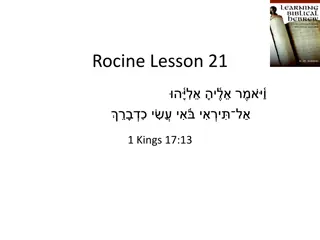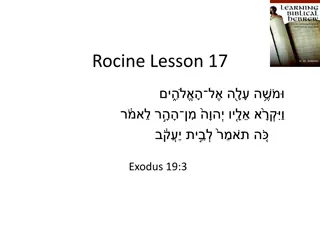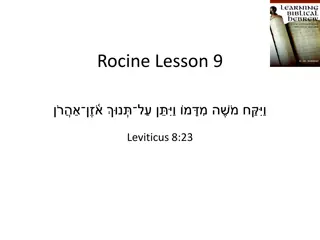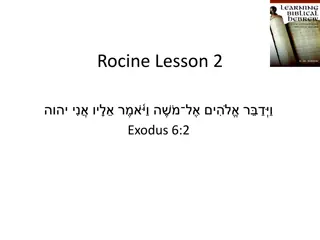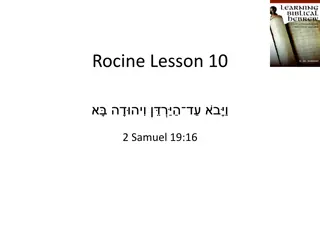
Identifying Yiqtol Verb Forms in Niphal
Learn to identify and read subjunctive yiqtol geminate roots in the Niphal form by analyzing specific examples from Joshua 7:9. Understand the nuances of interpreting clause-initial verb forms and their possible translations. Explore the distinction between wishes and possibilities expressed through the yiqtol verb form.
Download Presentation

Please find below an Image/Link to download the presentation.
The content on the website is provided AS IS for your information and personal use only. It may not be sold, licensed, or shared on other websites without obtaining consent from the author. If you encounter any issues during the download, it is possible that the publisher has removed the file from their server.
You are allowed to download the files provided on this website for personal or commercial use, subject to the condition that they are used lawfully. All files are the property of their respective owners.
The content on the website is provided AS IS for your information and personal use only. It may not be sold, licensed, or shared on other websites without obtaining consent from the author.
E N D
Presentation Transcript
Rocine Lesson 48 Joshua 7:9
Goals Identify and read subjunctive yiqtol geminate roots in the Niphal
What we already know What verb form is the first word?
What we already know What verb form is the first word? We-yiqtol (not wayyiqtol)
What we already know How have we learned to interpret this verb form, when it is clause-initial (Rocine 23.3d)?
What we already know How have we learned to interpret this verb form, when it is clause-initial (Rocine 23.3d)? Clause initial forms are almost always mainline. Offline verbs tend to be in a position other than at the beginning of a clause. (See rule in 23.3d) Mainline verb forms: Historical Narrative wayyiqtol Predictive Narrative weqatal Instructional Discourse weqatal Hortatory Discourse imperative, jussive, cohortative, weqatal So, we would expect an initial yiqtol to be jussive.
What we already know How could we translate the first phrase if we take the first word as jussive?
What we already know How could we translate the first phrase if we take the first word as jussive? Let the Canaanites and all the inhabitants of the land hear In context, however, the Israelites have just lost a battle to the people of Ai and Joshua is afraid that the Canaanites will hear the news and attack. In this instance the yiqtol clearly cannot be jussive even though it is in direct speech and is clause-initial (mainline).
What we already know In this verse, the yiqtol is not expressing a wish but a possibility. Wish Let the Canaanites hear Possibility The Canaanites mighthear
What we already know In this verse, the yiqtol is not expressing a wish but a possibility. Wish Let the Canaanites hear Possibility The Canaanites mighthear Both of these fall under the larger category Subjunctive Mood.
What we already know DEFINITION: Subjunctive mood is the speaker s expression of desire (which we know as the volitive forms) or possibility. The subjunctive mood contrasts with the indicative mood which is the speaker s expression of reality or knowledge.
Tense Aspect Modality What is mood (e.g. subjunctive mood or indicative mood)? How does mood differ from tense? How do these both differ from aspect?
Tense Aspect Modality In modern linguistics many languages (incl. BH) are often described in terms of Tense-Aspect- Modality (TAM) and it s really helpful to have some understanding of this.
Tense Aspect Modality Tense Location in time Past Present Future ... Aspect Relation to the flow of time A single block of time Continuous flow of time Repetitive occurrence Modality Degree of necessity, obligation, probability, ability. Expresses the attitude of the speaker toward what they are saying. Indicative mood Declarative mood Evidential mood Conditional mood Subjunctive mood o Desire (volitional) o Possibility Imperative mood Interrogatory mood May he He may, might https://en.wikipedia.org/wiki/Tense%E2%80%93aspect%E2%80%93mood https://en.wikipedia.org/wiki/Linguistic_modality
Tense Aspect Modality The term [Tense-Aspect-Modality] is convenient because it is often difficult to untangle these features of a language. Often any two of tense, aspect, and mood (or all three) may be conveyed by a single grammatical construction, but this system may not be complete in that not all possible combinations may have an available construction. In other cases there may not be clearly delineated categories of tense and mood, or aspect and mood. For instance, many Indo-European languages do not clearly distinguish tense from aspect. In some languages, such as Spanish and Modern Greek, the imperfective aspect is fused with the past tense in a form traditionally called the imperfect. Other languages with distinct past imperfectives include Latin and Persian. https://en.wikipedia.org/wiki/Tense%E2%80%93aspect%E2%80%93mood
Tense Aspect Modality Tense Location in time Past Present Future ... Yiqtol (yiqtol as simple future) Yiqtol (x-yiqtol in procedural discourse, Rocine 35) Aspect Relation to the flow of time A single block of time Continuous flow of time Repetitive occurrence Modality Degree of necessity, obligation, probability, ability. Expresses the attitude of the speaker toward what they are saying. Indicative mood Declarative mood Evidential mood Conditional mood Subjunctive mood o Desire (volitional) o Possibility Imperative mood Interrogatory mood Yiqtol (yiqtol as desire/ jussive) May he He may, might Yiqtol (yiqtol as possibility) https://en.wikipedia.org/wiki/Tense%E2%80%93aspect%E2%80%93mood https://en.wikipedia.org/wiki/Linguistic_modality
TAM in Biblical Hebrew For a succinct summary of TAM in BH see http://berithroad.blogspot.ca/2011/02/tense-aspect- mood-hebrew-verbs.html More a fuller discussion see http://www.artsrn.ualberta.ca/cocoon/JHS/a080.html http://berithroad.blogspot.ca/2011/02/tense-aspect-mood-hebrew-verbs.html
Ambiguities in the use of the yiqtol When a yiqtol is not clause-initial it may be either subjunctive or indicative. Subjunctive 2 Sam 19:31 Even all, may he take (it) Indicative Gen 46:4 And I, I will bring you up, even a going up 1 Sam 16:17 It is YHWH who looks at the heart
Ambiguities in the use of the yiqtol Once you have determined a yiqtol is subjunctive, it may be expressing either desire or possibility. Possibility Genesis 42:37 It is my two sons that you may kill if I do not bring him to you Desire Exodus 24:7 All that YHWH has commanded, may we do and obey (it)
Ambiguities in the use of the yiqtol Parse Root Stem Form PGN Function Root meaning
Ambiguities in the use of the yiqtol Parse Root Stem Form PGN Function Root meaning Qal We-yiqtol 3mp Express possibility To hear
Discourse Profile for Hortatory Discourse Lesson 19 1. Mainline a. Imperative b. Weqatal (for Mitigated Hortatory Discourse) c. Jussive d. Cohortative Lesson 21.6b.4 Lesson 23 Lesson 24 Lesson 24.4 Off-the-line: 2. Topicalization: X-Imperative / X-Jussive / X-Cohortative 3. Prohibitive Commands: or + yiqtol 4. Express possibility: yiqtol 5. Consequence, purpose: Weqatal 6. Consequence, purpose: or + yiqtol 7. Consequence, purpose: Embedded Predictive Narrative 8. Identification of problem: Embedded Historical Narrative 9. Backgrounded activities: Participle 10. Scene setting: Verbless Clause Lesson 21 Lesson 48 Lesson 22
Discourse Profile for Hortatory Discourse Lesson 19 1. Mainline a. Imperative b. Weqatal (for Mitigated Hortatory Discourse) c. Jussive d. Cohortative Lesson 21.6b.4 Lesson 23 Lesson 24 Lesson 24.4 Off-the-line: 2. Topicalization: X-Imperative / X-Jussive / X-Cohortative 3. Prohibitive Commands: or + yiqtol 4. Express possibility: yiqtol 5. Consequence, purpose: Weqatal 6. Consequence, purpose: or + yiqtol 7. Consequence, purpose: Embedded Predictive Narrative 8. Identification of problem: Embedded Historical Narrative 9. Backgrounded activities: Participle 10. Scene setting: Verbless Clause Lesson 21 Lesson 48 Lesson 22
Niphal of geminate roots Parse Root Stem Form PGN Function Root meaning
Niphal of geminate roots Parse Root Stem Form PGN Function Root meaning Off-line we-qatal: Purpose, consequence (here it s consequence) To turn aside surround Niphal Weqatal 3cp
Niphal of geminate roots Parse Root Stem Form PGN Function Root meaning Off-line we-qatal: Purpose, consequence (here it s consequence) To turn aside surround Niphal Weqatal 3cp For Niphal Geminate morphology study the verb tables. Also see Animated Hebrew chapter 39.
Polel, and Pilpel Polel and Pilpel are two special stems/binyanim that can occur with Geminates. Equivalent to Piel in meaning Important but Not many attested Easy to recognize
Polel Polel follows the pattern in all forms. Don t confuse this with the Qal Participle. See table in Rocine 48.5a
Pilpel The Pilpel stem is a result of doubling the essential two letters of a root. -> Qatal 3ms he is a roller II-Ayin and II-Waw also occur in the Pilpel -> Qatal 3ms he is a sustainer, nourisher
Pilpel The Pilpel stem is a result of doubling the essential two letters of a root. -> Qatal 3ms he is a roller II-Ayin and II-Waw also occur in the Pilpel -> Qatal 3ms he is a sustainer, nourisher Also see Animated Hebrew chapter 40.

